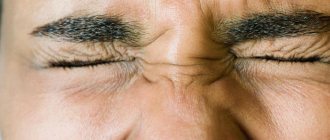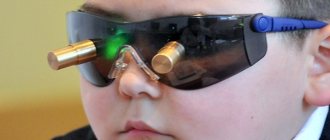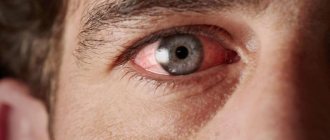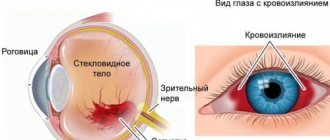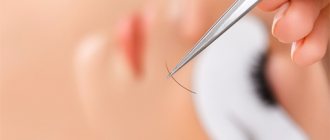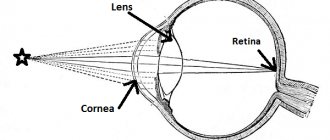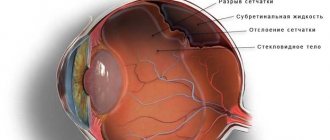Head or eye injury is quite common. They often affect children who fall and get hit during active games, industrial workers, athletes and other categories of the population. There are several types of such injuries that can cause negative consequences for vision. What is their danger?
Even seemingly insignificant damage to the visual organs or a head injury can cause pathological processes in the eyeball. The risk also lies in the fact that the results of a blow, burn, bruise or other injury may not appear at all for a long time, and then become apparent in an already advanced stage and lead to loss of vision. Let's look at the types of eye and craniocerebral injuries and their possible consequences.
Causes of redness
After an injury to the organ of vision, a red spot appears on the eye. The main factors behind bruises are everyday situations. In all cases, injury occurs due to mechanical impact. The most common is a blow: a ball or other object hitting the head during a game, a blow during sparring or a fight, etc. Any person can get a bruise, but most often athletes, children, military personnel and people whose work is subject to this type of injury increased physical activity is required.
The cause of injury is the transfer of kinetic energy from the body to the eyeball and orbit. As a result, blood vessels rupture and tissue damage.
Most common eye injuries
A blow to the eye can cause contusion of the orbit. With such an injury, soft tissues are not damaged and the integrity of the skin is not compromised. The main problem is that the eye not only becomes red, but there is limited mobility of the eyeball and visual acuity decreases.
If, as a result of the blow, damage to the skin occurs, the integrity of the tissues and organs located near the organ of vision may be damaged: the lacrimal gland, the muscles of the eye, the lacrimal canal.
Proper first aid is the key to recovery
An eye injury is a serious damage to the visual organ, which in any case requires an examination by an ophthalmologist. Self-medication is unacceptable, as this can lead to irreversible, serious disorders and changes in the entire visual system, including loss of vision. As a first aid measure, you can resort to emergency measures, after which you must have your eye examined by a doctor.
In case of eye injury, the doctor may prescribe bed rest, calcium supplements and hemostatics. If the eyeball becomes red after an impact, in order to remove the redness, it is recommended to perform the following manipulations yourself:
- Place an ice bag on the orbit of the eye. Place disinfectant drops into the eye.
- If severe pain bothers you, take a painkiller and consult a doctor.
If, due to injury due to hemorrhage, the white of the eye has become red, this does not mean that it urgently needs ophthalmological surgical intervention. Of course, as a result of injury to the eye after an impact, upon initial examination, redness of the organ of vision is a sad and unattractive sight, and even scary to look at. However, if the bruise is not severe and the correct timely measures are taken, surgical action is not required, and the subconjunctival hematoma will soon disappear.
Bruising in the eye: degree of danger, consequences
Hello Alice.
Bruising to the eye is one of the most common consequences of blunt force trauma. It’s okay if after the blow there is swelling with a hematoma under the eye - this is damage to soft tissues, which almost always goes away without consequences. An extremely bad symptom is the formation of a bruise in the eye after a blow, as a result of which the victim feels pain, pain, and discomfort. This type of injury cannot be delayed. You should seek help from an ophthalmologist as soon as possible for an explanatory consultation. Under no circumstances should you make any diagnoses or drop anything into your eyes without a specialist.
How long does it take for a bruise in the white of the eye to go away?
It is difficult to say without a preliminary examination how long this bruising will take. The fact is that in this case everything depends on the specifics of the hemorrhage, its extent, location, etc. If the bruise is external (localized on the surface of the eyeball), it will take about a week to resolve. This time can be shortened by using special eye drops (for example, potassium iodide, emoxypine, etc.), which are recommended by the doctor.
Internal hemorrhage is a separate topic for discussion. It's not that simple here. Such hemorrhage cannot go away on its own. It requires long-term and consistent hospital treatment. Naturally, it is impossible to assume any deadlines in this situation. That is why it is so important to consult a doctor in a timely manner so that a specialist can study the nature of the injury and the degree of danger of the damage, which will allow timely and effective therapy to be prescribed.
Consequences of ocular hemorrhage. Effect of injury on vision
There are quite a lot of consequences. Some of them have absolutely no effect on the damaged eye and vision in general. It’s worse when complications after an impact negatively affect vision, significantly worsening it. Here again I remind you of the need to see a doctor, because... You are unlikely to be able to independently identify the nature of the damage and the consequences.
If you only have redness in the white of your eye and no other symptoms, the diagnosis will likely be subconjunctival hemorrhage. I’ll say right away that such hemorrhage, caused by rupture of blood vessels in the eye, is not particularly dangerous. In most cases, it can be treated at home, but in your situation it is important to correctly identify it, because... the injury can be much more complex and dangerous.
How to treat subconjunctival hemorrhage?
This injury usually does not require special treatment. Quite quickly, the bloody stain on the squirrel goes away on its own. At first you will be bothered by painful sensations and cramps. It may feel as if there is something in the eye that is in the way, as if there is a foreign object there. Upon visual inspection, the damaged eye naturally does not look the most presentable. If you experience discomfort, ask your doctor about special eye drops that reduce pain and speed up blood resorption. This way the redness of the white will go away much faster. On average it takes about two weeks. During this time, the hemorrhage completely resolves, and the eye returns to its original appearance.
If the blow was too strong or fell on a particularly sensitive area of the eye, then you will have to take care of the health of the eye in advance, because Serious complications may develop, the most common of which is blurred vision. In fairly rare situations, surgery is required.
Sincerely, Natalia.
Diagnostic methods
To determine the extent of damage to the organ of vision due to an impact, it is necessary to undergo a full diagnostic examination. The ophthalmologist’s task is to eliminate the most dangerous consequences of eye injury. After this, the doctor will prescribe the correct effective treatment. During the initial examination, the doctor carries out the following diagnostic measures:
- Visually examines the patient's injured eye.
- Sets visual acuity. Determines the sensitivity of the cornea.
- Measures intraocular pressure.
These activities are the main ones. Depending on the results of the mandatory primary diagnosis, additional examination methods may be required. There are situations when it is necessary for the patient to be consulted by the following highly specialized specialists:
It is important to get tested
The first step after receiving an injury is to contact an ophthalmologist, who will examine the eye and make a decision regarding the risk of damage.
If conjunctival hyperemia is detected, the diagnostic search is carried out according to the following scheme:
- Standard visual inspection;
- Determination of the sensitivity of the cells of the corneal layer;
- Visual acuity measurement;
- Measuring intraocular pressure.
These techniques are basic and mandatory. Naturally, the examination can be supplemented with other more accurate diagnostic methods. Also, in some cases, additional consultation with related specialists is recommended:
- Therapist;
- Traumatologist;
- Neurosurgeon;
- General surgeon.
Among the main symptoms that appear against the background of eye injury, the first place is occupied by redness of the mucous membrane.
Effective treatment for redness
If the squirrel turns red due to a blow, in most cases there is no need for special treatment. It is necessary to monitor the general well-being and condition of the affected organ of vision and “notice” whether new dangerous symptoms have arisen. If the injury is more serious, the doctor may prescribe the following medications to remove redness from the eye:
- maintenance eye drops;
- local antibacterial medications - to prevent the development of inflammation and infection.
You should not use any medications yourself or make lotions or compresses with traditional medicine without consulting your doctor. This can further damage the affected organ of vision.
How do you know if surgery is necessary?
If you have red eyes, pain or other unpleasant symptoms, you should not hesitate to visit a doctor. Thanks to early diagnosis and consultation with an ophthalmologist, it will be possible to prevent the negative consequences of visual injury. In some situations, the damage is so severe that it is impossible to do without surgical ophthalmological intervention. The operation is necessary in the following situations:
- retinal detachment;
- damage to the cornea and the integrity of the eyeball;
- lens displacement;
- damage to the adnexal apparatus of the organ of vision.
Return to contents
What complications will occur if left untreated?
Eye injury can be dangerous in its consequences. This is not a situation where a trip to the ophthalmologist can be neglected. There is a risk of serious consequences for the eye, one of which is retinal detachment. From the point of view of diagnostic measures, it is important to exclude the occurrence of dangerous complications. Only a qualified specialist can handle this task. It is important to know that due to injury to the organ of vision, in some situations, visual acuity can sharply decrease, inflammation in the brain can develop, and even complete blindness can occur.
Redness of the eyeball after a blow
Eyes are very delicate and most unprotected organs that are vulnerable to mechanical irritations. They especially suffer from direct blows. In general, the eyeball itself has an elastic structure, thanks to which it can withstand even the strongest blows.
After the blow, the eyeball becomes red and swollen. Complications of injury are not only external manifestations; damage can cause significant harm to the entire visual apparatus. Trauma can damage the lens, cornea, retina, and even the optic nerve.
A direct injury is one in which a person hits his eye with a blunt object. If he received a concussion of the torso, then the eye is injured against the bony walls of the orbit - an indirect injury. During the impact and after it, the person experiences severe pain. In the first hour after injury, headache, dizziness and nausea often occur.
Unfortunately, few people know how to treat a red eye after an injury. A competent specialist will help answer this question. Before we talk about what to do in case of a concussion, let's look at the characteristic signs of eye damage.
Classification of bruise
Eye injuries are divided depending on the degree of damage:
- Easy. Does not affect the quality of visual function.
- Average. Causes short-term visual impairment.
- Heavy. Characterized by a persistent decrease in visual function.
- Particularly heavy. Can lead to complete blindness.
Despite the elasticity of the eyeball, a bruise can cause various types of damage, namely:
- trauma to the anterior chamber of the eye and cornea. If the eye was closed during the impact, then the eyelid may also be damaged. Swelling, hematoma, bleeding, and closure of the palpebral fissure appear. If the pathological process affects the cornea, its structures and transparency are destroyed, and erosions also appear;
- bruising of the eyelids can lead to damage to the adhesions, which manifests itself in the form of continuous tearing. If the cartilaginous structure of the eyelid has been damaged, this causes the formation of a defect and drying of the cornea;
- damage to the iris of the eye. This leads to the fact that the iris loses its ability to narrow and expand, and therefore cannot respond to light. The process may also involve the nerve endings of the iris. The hemorrhage appears as a dark red spot in front of the pupil;
- when the vitreous body is bruised, blood permeates the entire surface of the eye, which is why a person is only able to distinguish light;
- Injury to the ligaments can cause disruption in the functioning of the lens that they support. This is fraught with clouding of the lens, that is, the development of cataracts;
- retinal damage. It may even peel off. This usually happens when hit with great force;
- contusion of the optic nerve threatens complete loss of vision.
Main types of eye injury
According to the severity, ophthalmologists distinguish the following injuries to the organ of vision:
- lungs that do not affect visual function;
- medium, in which visual acuity decreases for a short time;
- severe, leading to a fairly stable impairment of visual function;
- especially severe, resulting in complete loss of vision or the eyeball.
A blow, either intentional or unintentional, can result in one of the following injuries. It does not have to be inflicted with a heavy object; in some cases, a blow with the hand is enough for an injury to occur.
Clinical symptoms
Contusion of the visual organ manifests itself in the form of the following symptoms:
- impaired movement of the eyeball;
- redness of the conjunctiva;
- hemorrhage into the white of the eye;
- swelling, pain, pain;
- worsening reaction to light;
- bulging or sinking of the eyeball;
- drooping upper eyelid;
- blurred vision;
- diplopia – double vision;
- the palpebral fissure does not close;
- continuous tearing;
- involuntary closing of the eyelids;
- nausea, dizziness, headache;
- in severe cases, loss of consciousness is possible.
A minor contusion does not always manifest itself as typical symptoms of eye injury. For example, a branch that hits the eye or a bounced ball can only hit the superficial layers and not cause pain.
First aid
Let's look step by step what needs to be done after an impact:
- Give your eyes complete rest. Any physical activity should be avoided. Don't even turn your head or move your eyeball.
- Apply cold. You can wet a towel with cold water or wrap ice cubes in a cloth. Cold is applied to the eye through closed eyelids, and the temporal part should also be involved. Apply the towel for fifteen minutes and repeat after ten minutes.
- Place disinfectant drops into the conjunctival sac.
- A sterile bandage must be applied to the eye. This will relieve hypersensitivity to light.
- For acute pain, you can apply cold compresses, which are changed every fifteen minutes.
- In case of severe pain, take an analgesic.
- Immediately take the victim to a specialized facility.
- Use Polimedel electret film. It can be used for up to four hours. The device normalizes blood circulation, tissue nutrition and metabolism. As a result, the healing process is accelerated.
Treatment methods
After examining an eye that has become red as a result of an injury, it becomes clear how to most effectively treat such damage. Basic recommendations usually include the following points:
- Using drops that contain a disinfectant.
- If severe pain occurs, you can take a painkiller and immediately go to the hospital.
- For symptoms of hemorrhagic hemorrhages, it is necessary to use hemostatic agents, as well as iodine and calcium.
- In case of severe and combined injuries, bed rest should be observed.
Features of treatment
A red eye is not the only sign of mechanical damage. During the examination, other manifestations may be noticed that are noticeable only to a specialist. That's why you shouldn't self-medicate!
In case of eyelid defect, primary surgical treatment is performed. To strengthen the walls of blood vessels, Ascorutin tablets are prescribed. If the blow is severe, the doctor may prescribe bed rest. Hemostatic agents (hemostatic agents) and calcium supplements help speed up the healing process. Sometimes antibiotics are required.
Important! Self-medication is fraught with irreversible consequences on the visual system and complete loss of vision.
Surgical intervention is indicated in the following cases:
- retinal detachment;
- damage to the eyeball;
- lens displacement;
- corneal damage;
- disturbance in the functioning of the adnexal apparatus.
If vision is not impaired, you should still consult an ophthalmologist three months after the injury.
Now let's talk about treatment tactics depending on the type of damage:
- superficial damage. They usually occur when foreign bodies enter: particles of earth, stone, metal. Patients complain of severe pain, lacrimation, photophobia, redness, and foreign body sensation. Therapeutic tactics include removing the foreign object and applying an antiseptic bandage;
- penetrating injuries. They can cause damage to the eyeball and complete loss of vision. Such injuries are usually caused by piercing or cutting objects, bullets or bullet fragments. Patients experience severe pain and significantly reduced vision. Treatment is carried out in a hospital setting. After the x-ray is taken, a qualified technician removes the foreign object;
- blunt injuries. Such injuries occur from a blow with a blunt object: a fist, a stick. There are almost always no external injuries, so a person may not even be aware of the injury. Some time after the injury, pain and a feeling of fullness appear, vision deteriorates;
- burns. They can be chemical, radiation or thermal in nature. The eye should be rinsed with plenty of water and medical attention should be sought.
Diagnosis and treatment
When you see a doctor after a head or eye injury, he will prescribe diagnostics: x-rays, examination of the fundus and retina, encephalogram, MRI and other tests as necessary. Trauma therapy is aimed at obtaining two results: preserving the eye itself as an anatomical organ and its structures and restoring vision. If you turn to specialists too late, despite all their efforts and the capabilities of modern medicine, a positive result cannot always be achieved. Very often, irreparable consequences occur precisely because of a careless and inattentive attitude towards one’s health.
The treatment method is selected depending on the type of damage.
Penetrating injuries require hospitalization and surgery, especially if foreign objects enter the eyes. For burns, thorough rinsing is carried out and then eye drops are prescribed. If hyphema (bleeding in the eye) occurs, aminocaproic acid and antifibrinolytics are prescribed. In severe cases, when the cornea is affected, surgery is performed. If the lens is significantly damaged, it can be replaced with an intraocular lens.
It is necessary to check the quality of vision after eye and head injuries to avoid the development of negative consequences. With the help of devices, the doctor will see changes in the structures of the eyes, even if everything looks fine on the outside. Statistics say that in 80% of cases, blindness could have been avoided if a person had consulted an ophthalmologist in time.
ethnoscience
Let's consider effective traditional medicine recipes that will help get rid of the unpleasant symptoms of an eye injury:
- Mix a teaspoon of calendula tincture with a third of a glass of water. The resulting solution is used in the form of a compress, which should be applied three to four times a day;
- Mix turmeric and ginger in equal proportions and then add a little water. The resulting pulp is applied to the hematoma, wrapped in cellophane and a warm scarf;
- Mash a fresh cabbage leaf until the juice appears, and then apply to the affected area;
- Finely chop the parsley and add a small amount of sour cream. Apply the resulting mass to the skin around the eyes.
So, redness of the eye after a blow is a natural phenomenon. Along with this, vision may deteriorate, photophobia, lacrimation, pain, a feeling of sand, and more may occur. Left untreated, it can lead to complete blindness. Timely, qualified help will help you avoid serious complications and recover faster!
Red eye after being hit
After a blow to the head, there are cases when the white of the eye forms red.
Pain and pain appear in the affected area, and the tissues swell.
Possible internal or external hemorrhage.
This situation becomes dangerous to the life and health of the patient. To prevent complications, it is recommended to consult a traumatologist or ophthalmologist. He will carry out diagnostic measures and determine the cause of the redness. The medicine or procedures will be selected individually, depending on the state of health.
What are the types of eye injuries?
Depending on the cause of the damage, eye injuries can be divided into the following types:
- penetrating and through wounds;
- blunt trauma;
- eye contusions;
- burns of various kinds (chemical, thermal).
Penetrating injuries can be caused by any sharp object that cuts tissue and goes deep inside for some distance: for example, when glass, a tree branch, wire, etc. get into the eye.
Blunt injuries (contusions) occur when any large object enters the orbital area, causing severe bruising of adjacent tissues. For example, such injuries often occur during team ball games: basketball, rugby, volleyball. The speed of the ball in them can reach 200 km/h. If a projectile hits the face at such a speed, not only soft tissue bruises can occur, but also a fracture of the nose, zygomatic bone, or the bottom of the orbit, and its contents can move into the maxillary cavity. Blunt trauma often causes hyphema - hemorrhage in the anterior cavity of the eye, a sharp increase in intraocular pressure.
Contact of various household liquids (cleaning products, ammonia, hairspray or hair dye) into the eye causes various degrees of burns to the mucous membrane. Eye burns can also occur from welding, a quartz lamp, or open fire. Getting various small particles (dust, sand, metal shavings) into the eye often causes serious injuries.
Diagnostics
If the eyes are red, bleeding may occur after the blow. The condition must be diagnosed in order to receive treatment on time:
- general examination of the condition of the mucous membrane, cornea, conjunctiva;
- instillation of agents that eliminate the accommodation of the eyes, which makes it possible to identify the condition of the lens and retina;
- measuring visual acuity using special tables that the patient looks at, identifying letters or pictures;
- measuring visual acuity using special ophthalmological devices;
- measurement of arterial and intraocular pressure;
- the use of MRI, CT to diagnose the condition of the eyeball, blood vessels, and brain.
Using diagnostic tests, the cause of redness and hemorrhage is determined. The doctor prescribes treatment.
Red eyes due to an impact can be caused by many conditions.
After identifying them, the doctor will prescribe therapeutic measures that can eliminate negative symptoms:
- Use of moisturizing, metabolic, antiseptic, antibacterial drops. They eliminate the disturbance formed on the surface of the eyes.
- The use of agents that help eliminate minor hemorrhages.
- Painkillers that are used as symptomatic therapy to eliminate acute pain.
- Drops that help reduce intraocular pressure by draining fluid from the chambers of the eyes.
- A surgical intervention that eliminates damage to blood vessels, internal structures of the eyes and neighboring tissues.
Complications
In the absence of therapeutic measures, the following complications for the patient’s health may occur:
- decreased visual acuity up to its complete loss;
- atrophy of the retina, optic nerve;
- malnutrition of the eyeball, as a result of which it ceases to function;
- spread of bleeding to nearby tissues;
- impaired vascular functionality.
The prognosis depends on the severity of the impact and the cause of the redness of the eyes. If the condition is caused by minor bleeding that will resolve on its own, the prognosis is positive. No therapeutic action is required.
If bleeding is significant, emergency therapeutic measures are required. If they were performed on time, the prognosis is positive, the patient will keep the organ of vision intact. In the absence of therapeutic manipulations, the prognosis is unfavorable. The condition can lead to complete loss of vision or death of a person.
Classification of injuries
According to the degree of severity in ophthalmology, it is customary to distinguish several types of injuries. Among them are:
- Light, not significantly affecting the function of the organs of vision.
- Moderate severity, when vision is partially affected and for a short period of time.
- Severe injuries can cause permanent visual impairment.
- Extremely severe injuries involve complete loss of the eye or its function.
A simple blow can cause any of the injuries described. The blow may be caused by a person or object, and does not have to be intentional.
Prevention
To prevent eye redness after impacts, it is recommended to use the following principles:
- timely consultation with a doctor, diagnostics and treatment procedures;
- state of rest after the impact, it is prohibited to perform any physical activity;
- It is recommended not to use contact lenses until you see a doctor.
A blow to the head is a condition that can cause serious complications, including bleeding into the internal structures of the eyes. It is important to consult a specialist in time and diagnose the patient’s health condition. With immediate treatment, the risk of complications is reduced.
How can some eye injuries affect vision?
The consequences of damage can be very sad. The main causes leading to loss of vision are eye burns of various types, contusions and penetrating wounds with damage to the internal structures of the eye. If such a case occurs, then hospitalization and therapeutic or surgical treatment are necessary.
Thus, a severe chemical burn can cause destruction of the retina and choroid, their detachment from each other, as well as damage to the vitreous body and lens of the eye. Alkali that gets into the eyes leads to atrophy of the optic nerve, the formation of a cataract, secondary glaucoma, and blurred vision. A particularly caustic substance can cause tissue death of the cornea and conjunctiva. If you receive chemical or other types of burns, you should immediately contact a clinic, where a doctor will determine the severity of the injury and prescribe appropriate treatment.
Penetrating injuries to the eye, especially when foreign particles enter it, can also cause negative consequences for visual functions. Thus, purulent processes often begin to develop in the structures of the eyes, for example, serous iridocyclitis. At the same time, pus accumulates in the inner membranes of the eye, painful sensations arise, a deterioration in the quality of vision is observed, and the pupil narrows. If damage occurs in the limbus, clouding of the lens may occur and traumatic cataracts may develop.
Metal shavings that get into the eye color it brown (iron) or yellow-green (copper). Such foreign objects cause siderosis or chalcosis, which narrow the field of vision, secondary glaucoma can develop, retinal detachment can occur, and, as a result, blindness can occur.
The consequences of various damage to the organs of vision can appear even after several months or years. That is why, in the event of an injury, it is imperative to consult a specialist for a full examination of the internal structures, including the fundus of the eye, and then perform preventive examinations at least once every six months.



